Business software is essential for every company in the current landscape. It streamlines all kinds of business initiatives and helps you manage crucial data about your customers and prospects.
There are so many options available. In fact, the global market for customer relationship management (CRM) software alone is expected to reach $40.26 billion in 2023.
The tools every business needs fall under the three main areas of a company: marketing, sales, and customer service. The heart of your business software that brings all these departments together is your CRM platform.
Your CRM informs every aspect of your business and impacts every person in your company, so when it comes to finding the right software, you need a strong CRM from the get-go. In other words, you should do your homework before investing in the right business software.
Among the top rated options are Zoho and HubSpot.
What Is Zoho?
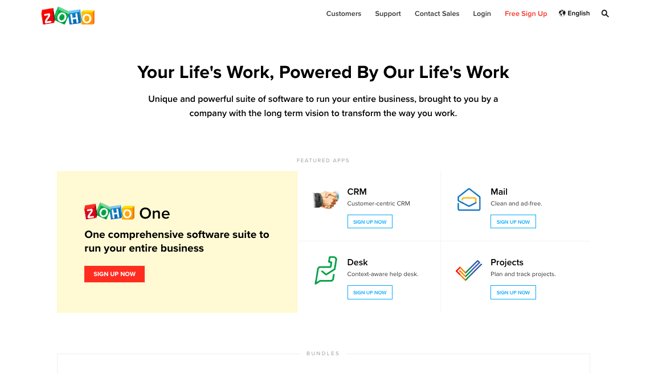
Based out of India, Zoho provides one of the world’s leading suites of business software tools. To say that they offer a lot of apps is an understatement.
Their selection of apps is wide ranging. Here's a look at what their most notable apps within each of the following categories.
Sales and Marketing Apps
The apps they offer for marketing and sales teams help businesses attract targeted traffic, convert them into leads, and close the most qualified prospects as new customers.
The most notable of their 15+ associated apps include the following:
- Campaigns
- Forms
- Social
- SalesIQ
- SalesInbox
- MarketingHub
- Sites
Essentially, you can cover all your marketing and sales needs by paying for each of these apps.
Email and Collaboration Apps
To bring your team together and make the most of your workforce, take a look at some of their apps, which include:
- Meeting
- Vault
- Sprints
- Docs
- WorkDrive
- Projects
From document management and slideshow creation to workflow and project management and beyond, you can find any and all solutions within the Zoho platform.
Finance Apps
Accounting and managing your business finances can be complex, but thanks to the following apps, you can oversee everything from inventory management and invoices to expense reports and more:
- Books
- Inventory
- Invoice
- Subscriptions
- Expense
- Checkout
Bringing all these apps together keeps all your business financials visible for the right people. This makes important tasks like cashflow management simple for your leadership teams.
Additional Business Apps and Bundle Options
Zoho's tools cover all the bases, including human resources, business intelligence and analytics, and IT and help desk. The good news is that you don't have to piece every app together.
You can bundle it all under their Zoho One option. They also offer the following bundles:
- CRM Plus – a fully unified platform that you use to deliver an awesome customer experience.
- Workplace – one integrated suite that drives productivity and fosters collaboration.
- Finance Plus – cover all your bases from invoicing and order management to accounting.
- IT Management – the perfect mix of tools for optimizing operations and aligning IT with your business.
- People Plus – create an excellent employee experience with their suite of digital HR tools.
Zoho CRM
One of the most popular software options on the market, Zoho CRM offers a ton of features so you can ensure you're taking a customer-centric approach to growing your business.
The most notable features of their CRM include:
Marketing Automation
You can use your CRM to segment your database into lists to deliver hyper-targeted content, as well as manage your lead nurturing campaigns by keeping up to date with all your customer interactions.
Sales Enablement
Save your sales team time by giving partners access to edit contacts in your CRM, integrate your G Suite and Office 365, and generate and deliver quotes and invoices. All within the CRM.
Performance Management
Keep your team productive by gamifying their individual performance. Additionally, get accurate forecasts of potential revenue coming down the pipe, and assign the right sales team members to their most relevant customers based on categories (like location and other criteria).
That's just a few of the many features that Zoho CRM provides. What’s more, all of these apps they provide integrate seamlessly with other leading software options.
You can see why Zoho is often a top choice for business software.
Price: Starts at $18 per user per month for their standard tier if you pay monthly, and it goes up to $45 per user per month for enterprise. The free edition includes three free users and limited features.
What Is HubSpot?
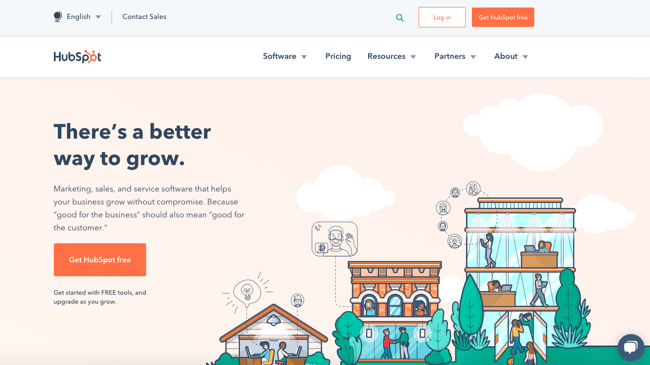
Based in Boston, MA, HubSpot is the leading name for all things inbound. They're one of the world's biggest SaaS companies that provides software tools for marketing, sales, and customer service.
They help you organize your business processes in three different hubs. Here's what each of those hubs are and what each tier provides.
HubSpot Marketing Hub
Your goal with all things marketing is pretty straightforward: Drive traffic and convert leads. The Marketing Hub tools at your disposal within HubSpot support these goals in many different ways.
The best part is that you can start with a lot of free tools to get you started, then upgrade to the next tier as you grow. Here's a look at what each tier provides:
Free
Start with the basics. Features in the free hub include:
- Forms – including pop-ups, external form tracking, and native forms.
- Email marketing – 2,000 sends per month.
- Ad management – $1,000 spend limit for simple website audiences only.
- List segmentation – five smart lists and 25 static lists.
- Live chat
- Conversational bots – limitations apply.
- Reporting dashboards – one dashboard with 10 reports.
- Custom properties – limit to 10.
- Team email
- Messenger integration – limitations apply.
That's a lot of awesome tools at your disposable for no upfront costs.
Starter
The aforementioned free tools are upgraded with more functionality and less limitations when you pay for starter. In addition, you also get these new tools:
- Landing pages – limitations apply.
- Ad retargeting – $1,000 spend limit for two audiences.
- Multiple currencies – up to five currencies.
These are great additions as you scale your business. These tools are specifically built to help you drive more conversions.
Price: Starts at $50 per month, or $40 per month if you pay annually.
Professional
As you upgrade to this level, you gain more functionality and less limitations with your starter tools, as well as gain access to the following new tools:
- Phone support
- Blog and content creation tools
- SEO and content strategy tools
- Google Search Console integration
- Calls to action
- SSL certificate
- Social media – 50 connected accounts, 10,000 posts per month, and scheduling up to three years in advance.
- Competitor tracking – up to 10 competitors.
- Subdomain availability – one subdomain.
- Marketing automation – up to 300 workflows.
- Salesforce integration – 1,000 field mappings, 10,000 owners, and one account.
- Attribution reporting – one attribution model and two attribution objects.
- A/B testing
- Video hosting and management
- Teams – up to 10 teams.
- Custom reporting – 20 custom reports.
- Standard contact scoring – one scoring property.
- Campaign reporting – 1,000 campaigns.
- Filtered analytics view – 25 views
- Calculated properties – five properties.
- Website traffic analytics
- Record customization
The jump from starter to professional is a big one, in terms of both price and added functionality. However, when you make this transition, you're building a well-oiled marketing machine where you can do everything you need to do using one platform.
Price: Starts at $800 per month.
Enterprise
The last tier, as you can imagine, provides more functionality and less limitations as well. Additionally, you gain access to these tools:
- Hierarchical teams
- Adaptive testing
- User roles
- Single sign-on
- Custom event triggers and reporting
- Event-based segmentation
- Predictive lead scoring
- CMS membership
- Multi-touch revenue attribution
The list goes on, giving you access to tools that help you execute your most comprehensive marketing campaigns you can imagine.
Price: Starts at $3,200 per month.
HubSpot Sales Hub
Sales software helps your team automate their processes so they can fill their pipelines and speed up the sales cycle to close deals faster.
The Sales Hub is structured just like the Marketing Hub, providing various tools at each tier:
Free
You can hit the ground running with some basic sales tools. The most notable ones include:
- Live chat
- Conversational bots – limitations apply.
- Conversations inbox – one inbox.
- Calling – 15 minute limit.
- Email scheduling
- Email tracking and notifications – 200 notifications.
- Email templates – five templates.
- Canned snippets – five snippets.
- Documents – five documents.
- Meeting scheduling – one personal meetings link.
- Reporting dashboards – one dashboard with 10 reports.
- Deal pipeline – one pipeline.
- Custom properties – limit to 10.
- Team email
- Messenger integration – limitations apply.
Those tools can speed up your sales cycle in no time. For free.
Starter
The upgrade to starter opens up the doors for the following notable tools:
- Conversation routing
- Rep productivity performance
- Quotes
- Deal stage, task, and lead rotation automation
- Email support
- Goals
Overall, this tier is a great fit for smaller businesses that have a few reps on hand.
Price: Starts at $50 per month, or $40 per month if you pay annually.
Professional
Businesses on the cusp of growth can take their revenue to the next level by leveraging all the awesome HubSpot Sales Hub tools mentioned already, as well as these tools that you get with the professional tier:
- Workflow extensions
- Esignature
- Phone support
- Custom reporting
- Products
- Slack integration
- Record customization – limitations apply.
- Calculated properties – five properties.
By using these tools strategically, you can really speed up your sales cycle and drive results fast.
Price: Starts at $500 per month.
Enterprise
This tier is perfect if you're looking to coach your team at scale and manage your growing team. Here are some notable tools you get with this tier:
- Predictive lead scoring
- Hierarchical teams
- Quote-based workflows
- Call transcription
- Recurring revenue tracking
- Playbooks – 1,000 playbooks.
- User roles
- Webhooks
- Single sign-on
At this level, your sales team is truly unstoppable.
Price: Starts at $1,200 per month.
HubSpot Service Hub
Your customer service team needs to be focused on delighting and retaining your customers and even finding upsell and cross-sell opportunities.
The HubSpot Service Hub includes the same four tiers.
Free
For no charge, you can start delivering excellent customer service using several free tools you get through the other free hubs (e.g., live chat, conversational bots, meeting scheduling, messenger integration) as well as these Service Hub tools:
- Ticketing
- Email and chat to ticket
- Ticket creation bots
- Calling – 15 minutes.
- Tickets closed reports
- Rep productivity reports
With these free tools, you can really elevate your service team and make the most of their efforts.
Starter
When you upgrade to this tier, you gain these awesome tools:
- Email scheduling
- Calling SDK
- Conversation routing
- Ticket pipelines – two total.
- Multiple currencies – five total.
Between these new features and less limitation on your free tools, the starter tier sets you up to continually delight and support your awesome customers.
Price: Starts at $50 per month, or $40 per month if you pay annually.
Professional
When you're ready to scale your service team, the professional tier is your next best step. You can unlock these tools:
- Knowledge base
- 1:1 video creation and hosting
- NPS surveys
- Customer experience surveys
- Customer support surveys
- Customer reporting
- Ticket status, routing, and automation – 300 workflows.
- Teams – 10 teams.
- Insights dashboard
- Salesforce integration
- Phone support
- Sequence queues
- Standard contact scoring – one scoring property.
- Customer service automation – 300 workflows.
- Record customization
- Slack integration
This is where you can support your customers with valuable self-help options, like a knowledge base, and you can also stay on top of measuring the customer experience using the survey tools.
Price: Starts at $400 per month, or $320 per month if you pay annually.
Enterprise
As your business grows, you're going to need to ensure consistency across the customer experience, while managing larger teams. This is where these great tools can help:
- Playbooks – 1,000 playbooks.
- Call transcription
- User roles
- Single sign on
- Webhooks
- Goals
- Hierarchical teams
As an enterprise HubSpotter, you have everything you need to deliver an exceptional customer experience at every touchpoint, which helps with retention, referrals, and upsell and cross-sell opportunities.
Price: Starts at $1,200 per month.
HubSpot CRM
The HubSpot CRM stands out in the world of CRM platforms mostly because of its reasonable price. Free.
And unlike many free tools, HubSpot CRM is not restrictive. The most notable features include:
- Reporting dashboards
- Deal tracking
- Pipeline management
- Company insights
- Deals
- Unlimited number of users
- Unlimited storage
- 1,000,000 contacts and companies
Not bad for a free, easy to use tool. You can make the most of this with any business software too. It integrates with several leading tools in email, calendars, prospecting software, team communications, social media, ecommerce, video, and much more.
Price: Free with no expiration or restricted access, according to the HubSpot Guarantee.
HubSpot Growth Suite
The best part about HubSpot is the fact that it all works together seamlessly. Just like how Zoho offers bundled options with savings, HubSpot offers Growth Suite at each tier.
The HubSpot Growth Suite includes:
- HubSpot CRM
- Marketing Hub
- Sales Hub
- Service Hub
Each tier aligns with the aforementioned ones associated with each hub. The higher the tier, the more tools you get.
So how does HubSpot and Zoho stack up against each other?
HubSpot vs. Zoho: How They Compare With Pros and Cons
There are many pros and cons associated with each of these platforms. One of the best ways to measure these against each other is to look at the heart of each of these platforms – their CRMs.
But the ultimate question is, how are real users feeling about their experiences using HubSpot and Zoho?
We looked at several leading review sites to find what the consensus is.
The Capterra Comparison
Capterra shows a close call, ultimately tipping in favor of HubSpot.
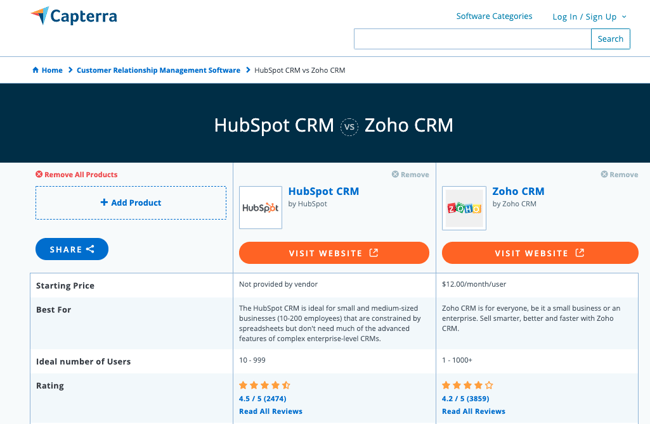
HubSpot won in the following categories:
- Ease of use
- Customer support
- Features and functionality
- Value for money
The Blueprint Comparison
Another reputable resource, The Blueprint, shows a close call, ultimately giving HubSpot the medal.

While Zoho earned a higher score in pricing, HubSpot outscored them in ease of use and tied them on support and features.
The G2 Comparison
G2's comparison shows a bigger gap in reviews between the two CRMs. HubSpot CRM has over 5,000 reviews, averaging 4.3 out of 5 stars, as compared to Zoho CRM that has a 3.9/5 stars as an average from over 1,600 reviews.
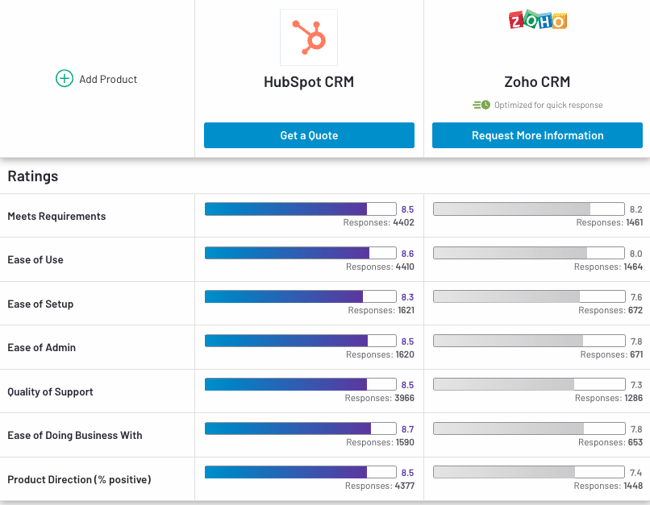
HubSpot CRM outscored Zoho CRM in the following categories:
- Meets requirements
- Product direction
- Easy of doing business
- Support quality
- Ease of use
- Ease of setup
- Ease of admin
The good news is, if you have a Zoho CRM and want to use it with your HubSpot software, you can integrate it.
How to Manage Your Zoho-HubSpot IntegrationYou can select a few different options to seamlessly integrate your Zoho CRM with HubSpot. The two best options are through the following tools:
- Zapier – a software automation and integration tool.
- Formstack Sync – a workplace productivity and integration platform.
Let's run through how to integrate your Zoho CRM with HubSpot using these two options.
How to Integrate Zoho With HubSpot Using Zapier
1. Sign up for a free account with Zapier.
2. Go to the HubSpot + Zoho CRM integrations page.
3. Review the triggers and actions to find which integrations you want to add.
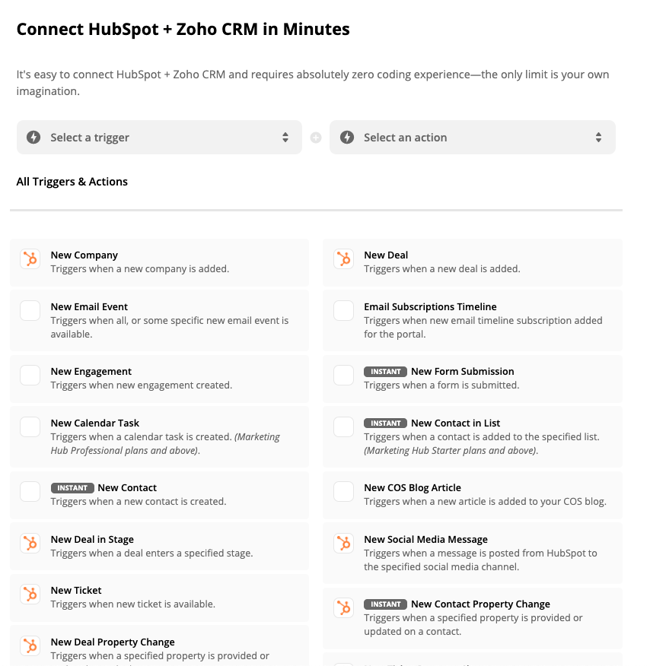
4. Click the Connect HubSpot + Zoho CRM button, and start creating any desired workflows you need.
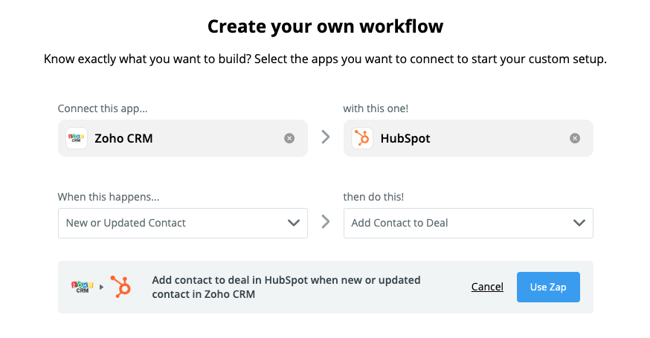
It's really that easy. This is why Zapier is the leading name in integration.
How to Integrate Zoho With HubSpot Using Formstack Sync
1. Create an account with Formstack Sync.
2. Navigate to Connectors and add HubSpot and Zoho.
3. Go to Mappings and customize how you want contact data to move from Zoho into HubSpot. You can also add and edit mapping fields.
4. Go to Workflows, where you can dictate how and when data syncs. These are built using if/then logic and add as many logic steps as needed.
5. Then, go to your dashboard and turn on the sync.
Within just a few minutes, you have your two business software platforms working together seamlessly.
When it comes to deciding which platform is your best bet, you need to consider everything from your budget to your business goals and the amount of people you have to dedicate to using one of these software options.
No matter your choice, there are plenty of ways to hit the ground running. Plus, as you see with the integration options, you can get the best of both worlds.
Do your research. Get your team bought into the software. Start driving results.


Jeff Previte
I am a Content Manager at Bluleadz. I enjoy spending time outdoors -- camping, hiking, hammocking, and everything in between. I also love reading, writing, and learning how to play guitar.